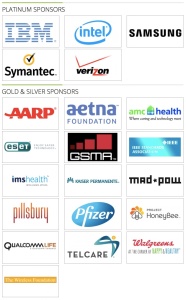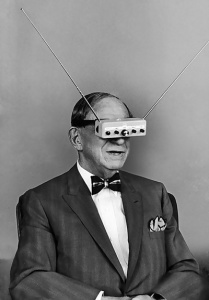 Mobile and digital technologies will bend the health care cost curve, drive individual and population health, and solve the nagging challenge of health disparities.
Mobile and digital technologies will bend the health care cost curve, drive individual and population health, and solve the nagging challenge of health disparities.
Mobile and digital technologies will increase costs to health providers, disrupt work flows and lower clinicians’ productivity, and hit a market bubble.
Depending on your lens into mHealth, and what product categories and user segments you’re looking at, all of the above can be true.
The plenary session of the 2014 mHeath Summit kicked off with Dr. Harry Leider, Chief Medical Information Officer of Walgreens, who spoke of the pharmacy’s evolving role across the entire continuum of care, from health-fitness-wellbeing, to self-diagnostics and acute care, through to chronic care and healthy aging. Dr. Leider’s overview of consumer-driven U.S. health care set up a useful landscape for putting other Summit presentations in context.
Dr. Leider confessed that, from the health care payor’s point of view, it’s hard to prove that investments in health and wellness save money in the short-term. However, in the long term, there are significant cost impacts for acute conditions, lowering the costs of care via remote care and self-monitoring, and for managing chronic care and aging-in-place where Big Data can help to “manage care by exception,” pointing out or anticipating adverse events and clinical problems of patients.
Dr. Leider offered a few considerations for cost-savings in digital health. It helps to have a CPT code that is reimbursable (for example, the 2015 CMS final rule expanding telemedicine coverage);
2. The window for proving impact on net short term total medical spend is 12 to 18 months; savings are difficult to generate without reducing hospital admissions; and,
3. Know that quality scores can positive impact ROI in digital health: look at the Medicare Advantage program’s STAR ratings programs that offer strong financial incentives for meeting quality standards, as much as a 5% bonus potential which can have a huge impact on thinning provider margins.
Walgreens sees consumers increasingly looking for lower cost, convenience, and support for meeting personally compelling health needs. The company reaches people through an omni-channel strategy, across media channels and digital platforms — where people are already living their lives outside of health care.
 That’s “where” health lives, but not so much health “care.” That chasm could be why we might be living in the era of irrational exuberance in digital and mobile health. “Mobile Snapchat, Whats App, Instagram – companies that go from a couple of kids to $8 billion in 2 years. Can’t we do that in health, too?” quipped Dr. Joseph Kvedar of the Center for Connected Health. “The typical app strategy won’t help us in health care,” Dr. Joseph Kvedar asserted. “We’re attracting fit people. But for health care delivery that needs to take care of sick populations and keep them healthy, this might be misplaced resources,” he recognizes.
That’s “where” health lives, but not so much health “care.” That chasm could be why we might be living in the era of irrational exuberance in digital and mobile health. “Mobile Snapchat, Whats App, Instagram – companies that go from a couple of kids to $8 billion in 2 years. Can’t we do that in health, too?” quipped Dr. Joseph Kvedar of the Center for Connected Health. “The typical app strategy won’t help us in health care,” Dr. Joseph Kvedar asserted. “We’re attracting fit people. But for health care delivery that needs to take care of sick populations and keep them healthy, this might be misplaced resources,” he recognizes.
What Dr. Kvedar and team have learned through years of doing pilots and research into connecting health providers and patients across a range of medical conditions and scenarios is that, “pushing a button for health improvement is too hard” compared with a person checking their mobile phone over 100 times a day.
“Don’t confuse education with inspiration – that’s telling you you’re sick versus activating people,” Dr. Kvedar has learned. “As we think of designing future of mobile health we have to go more toward inspiration. If we don’t mHealth will be another tech bubble which we cannot afford,” he sees.
Go where the consumer is, focus on near term goals, and embrace and adopt state of the art design, Dr. Kvedar recommends.
The design guru of the day (and on any day IMHO) was Amy Cueva of Mad*Pow, a design firm that’s doing some of the most cutting-edge innovative design in health/tech. “Design for the ecosystem of care,” Amy urged, referring to her iconic slide of a midnight blue sky with constellations of care nodes that are fragmented, unrelated, not inter-operable — long term care, hospitals, pharmacies, schools, doctors’ offices, labs, imaging centers, the FDA, countless other touch-points — and, the patient’s home.
“We are engaged by our empathy and we are collaborative in our mission to get there,” Amy explained. “We believe that design can cure the human condition. Mad*Pow brings to bear the voice of the person, Amy said.
She pointed to health plans which cause “a lot of pain for consumers,” she’s observed. “They’re selling a product few people really understand. Design helps. We pay attention to the emotions of the people we serve. A spike in emotion can be indicative of an at-risk individual. We look at peaks and valleys in engagement and see where we need to focus.”
As a consumer-facing, user-centered designer, Amy looks at three categories of health brand principles through the person’s lens:
1. I didn’t know – the lens of health literacy
2. I know I should – the motivational lens
3. I want to but I can’t – the lens of lack of resources – financial, geographic, language/translation.
Amy concluded with a quote from Cindy Gallop — that, in the ecosystem of health care, we can achieve things together – through shared actions + shared values = shared profit
Janet Schijns of Verizon brought the human dimension into the center of her talk about people looking for information “in the minute that matters.” Consumers’ desire to be in charge in daily life is the state the health-tech industry needs to get to, Schijns asserted. “How does ‘your’ app perform in the minute that matters to the customer?” is the relevant question.
Meet consumers where they are – because they don’t come to health care, Scott Snyder of Mobiquity told a fully-packed meeting room addressing the topic of health data, digital technology and consumers. We’re now in a new generation of wearables, compared to the previous one where you wore, as Snyder joked, “a VCR strapped to your wrist.” Today, a Ralph Lauren shirt is embedded with an OM Signal sensor. Snyder advocated for digital health tech to integrate with peoples’ lifestyles as well as their personal values for rewards — which could be “points” that result in dollars spendable at a pharmacy, but they could also be hotel or airline points, gift cards to stores, or charitable contributions to favorite advocacy organizations. “Everybody is motivated by something that’s different,” Snyder has found. Convenience and time-saving are also important rewards for many people. Consider the GPS app Waze, which crowdsources social real-timed traffic patterns that can give you back 50 hours in your year, Snyder calculated.
So is 2015 the coming-out year for connected health? That was the question on Dr. Joe Kvedar’s mind, as he raised a key point that comes from his long-time work with clinicians and patients at the Center for Connected Health in Boston. Joe’s presentation clicked from a photo of lively, healthy athletes donning wrist-wearables to an image of older, pudgier, grey haired people, one wearing a too-tight green graphic sweatshirt bearing a beer company label.
His point: that the people who bear the largest burden of chronic disease are those who might benefit most from mHealth technologies, and we’re still not getting these tools and benefits to them…and therefore, not driving significant ROI and outcomes that are possible through leveraging mobile platforms in health.
The bottom-line, he warns, is that we’re in the era of irrational exuberance for digital and mobile health – which Gartner’s Hype Cycle agrees (discussed here in Health Populi).
Health Populi’s Hot Points: The home is the fastest-growing health care site, noted Derek Aberle, the President of Qualcomm Life, in his keynote talk this morning on Day 2 at the 2014 mHealth Summit.
But “home” is where the person is – where she lives, works, plays, learns, prays, shops, and drives. Health is person-centric, and care delivery can be largely untethered physically from the hospital, the doctor’s office, and even the pharmacy (THINK: digital pills and sensor-laden patches to deliver continuous drug delivery over time).
I used to advise “eHealth” businesses in the pioneering era of the Internet in health care (see this paper for a blast from that past), and the “eBusiness” aspects in health care morphed and mainstreamed into health care workflows. Today, there isn’t health care without the ubiquity of the Internet, cloud computing, Big Data, and ever-present mobile phones and tablets in doctors’, nurses’, and patients hands.
We are at both the apex of the Hype Cycle and post-pilot phase of mobile health. Mobile is increasingly seen (correctly) as just another mode of care delivery – so on Twitter on the #mHealth14 feed, a dominant observation is that connected health, mobile health, and digital health are just….health.




 Thank you FeedSpot for
Thank you FeedSpot for